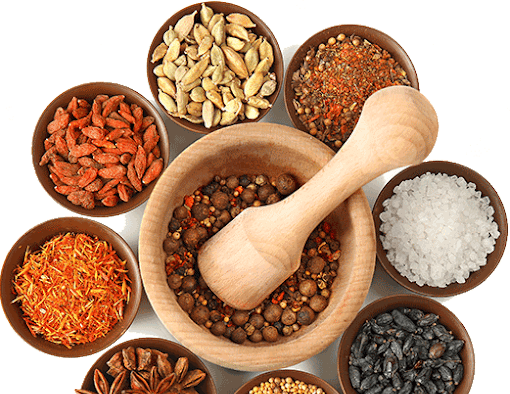Chew on a cardamom or a peppercorn, or inhale the aroma of freshly cured cinnamon bark – without warning, you are transported into a different state of being. Potent organic compounds saturate your palate and nostrils, working their aromatic enchantment. Immediately your brain switches gears. Your perceptions are altered, your mood is transformed. The sluices of memory open, spilling forth long-lost images and associations – a fondly-remembered family reunion, a lovers’ holiday in a foreign land. Strange sensations assail you: you break into a sweat, or salivate profusely, or feel your sinuses open up. You may feel unusually invigorated, or unusually relaxed; and that toothache or queasiness from which you were suffering has suddenly vanished.
Such is the power of spices, familiar to us all. Some folk make use of it to good psychological effect. A canny house-broker boils cinnamon in a pot of water to fill the houses she sells with a warm, comforting, homelike smell. A long-distance truck driver chews peppermint to help keep him alert and relaxed in the cab. A hung-over executive sucks on cloves to clear his head and freshen his morning-after breath.
Some of these amateur prescriptions have been validated by scientists; clinical trials show that peppermint really does seem to reduce stress and fatigue in motorists, as does cinnamon. And a recent study found that saffron may help in cases of mild to moderate depression which may explain why wealthy ancient Romans liked to sleep on pillows stuffed with it!
The apothecary’s store
The mood-enhancing and altering effects claimed for these and other spices are only one aspect of the curative and therapeutic powers attributed to them. Some of these claims are as old as time; fenugreek is said to cure baldness, ginger to possess aphrodisiac properties. Other claims are as new as this morning’s headlines: Cinnamon Offers Plethora of Health Benefits, Common Spice May Protect Skin During Radiation Therapy.
How valid are these claims? Some are probably old wives’ tales, such as the Roman gladiators’ belief that eating dill strengthens the body before a contest. And if such a thing as a cure for baldness exists, it certainly isn’t fenugreek! But other claims are far more credible. We know that long-ago healers made extensive therapeutic use of spices, which appear in every traditional pharmacopoeia and play a particularly important role in the ancient and elaborate traditional medicines of South Asia (Ayurveda) and China.
In fact, many spices marketed by the Ceylon Spice Company have important health-giving properties in Ayurveda: cardamom is said to clear the body’s airways and aid digestion, cloves are recommended for sore throats as well as toothache, coriander relieves cold symptoms and is sometimes used to treat allergies. Ginger is the Indian vishwabesaj, or ‘universal medicine’, though turmeric, the most versatile South Asian spice, may better deserve the name.
For centuries, Western medical scientists were sceptical about the efficacy of these traditional remedies even while traditional Ayurvedic physicians regarded spices as the medicaments of choice.
The last few decades, however, have seen much of this scepticism melt away – in the increasingly multicultural world spices have helped create, the exotic and the outlandish quickly become familiar, and people will adopt remedies that work, wherever they originate and whether or not ‘orthodox’ medical science approves of them.
Yet, increasingly often, orthodox medical science does approve.
Many traditional spice-based remedies have been given the nod by Western doctors, while others are under study in the belief that they may yield new treatments for the diseases that ail us in our modern lives. Among these, one potential superstar is turmeric, long known as an effective antibacterial agent, which now appears to have therapeutic properties even ancient physicians did not suspect.
Studies have suggested that extracts of turmeric could be useful in fighting degenerative diseases like arthritis and Alzheimer’s disease, protect cancer patients’ skin from damage caused by radiotherapy and may even help shrink their tumours. The active ingredient in most of these effects is curcumin, which gives turmeric (and hence garam masala or curry powder) their yellow colour.
Other researchers have found that spices, on the whole, help preserve intelligence and alertness, and retard the physical and mental effects of ageing. Cinnamon, the classic Sri Lankan spice, contains high levels of antioxidant compounds responsible for these benefits; it is also used as a digestive, carminative and cold remedy, and has significant antibacterial properties as well.
The spice of life
Variety, is ‘the very spice of life’. And indeed, the variety that spices add to our lives through their ability to bring zest and excitement to a dish of the simplest ingredients is what we most value them for. If they had no other virtue, for this alone we would still make eager use of them.
Yet we are doubly fortunate for the spices that flavour the foods we eat have benefits above and beyond the merely culinary. They also keep us sound in body and mind, helping – if the old Chinese, Indian and Sri Lankan doctors are right – to preserve the optimal balance of a healthy constitutions.
Spice of life, indeed!



